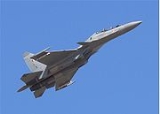
Su-30MKI
Encyclopedia
The Sukhoi Su-30MKI (NATO reporting name
NATO reporting name
NATO reporting names are classified code names for military equipment of the Eastern Bloc...
: Flanker-H) is an air superiority fighter
Air superiority fighter
An air superiority fighter is a type of fighter aircraft intended to gain air superiority in a war, by entering and seizing control of enemy airspace. Air superiority fighters are designed to effectively engage enemy fighters, more than other types of aircraft...
jointly developed by Russia's Sukhoi
Sukhoi
Sukhoi Company is a major Russian aircraft manufacturer, headquartered in Begovoy District, Northern Administrative Okrug, Moscow, famous for its fighters...
and India's Hindustan Aeronautics Limited
Hindustan Aeronautics Limited
Hindustan Aeronautics Limited based in Bangalore, India, is one of Asia's largest aerospace companies. Under the management of the Indian Ministry of Defence, this state-owned company is mainly involved in aerospace industry, which includes manufacturing and assembling aircraft, navigation and...
(HAL) for the Indian Air Force
Indian Air Force
The Indian Air Force is the air arm of the Indian armed forces. Its primary responsibility is to secure Indian airspace and to conduct aerial warfare during a conflict...
(IAF). A variant of the Sukhoi Su-30
Sukhoi Su-30
The Sukhoi Su-30 is a twin-engine, two-seat military aircraft developed by Russia's Sukhoi Aviation Corporation. It is a multirole fighter for all-weather, air-to-air and air-to-surface deep interdiction missions.The Su-30 started out as an internal development project in the Sukhoi Su-27 family...
, it is a heavy, all-weather, long-range fighter.
Development of the variant started after India signed a deal with Russia in 2000 to manufacture 140 Su-30 fighter jets. The first Russian-made Su-30MKI variant was accepted into the Indian Air Force in 2002, while the first indigenously assembled Su-30MKI entered service with the IAF in 2004. In 2007, the IAF ordered 40 additional MKIs. As of January 2011, the IAF has 142 MKIs under active service with plans to have an operational fleet of 280 MKIs by 2015. The Su-30MKI is expected to form the backbone of the Indian Air Force's fighter fleet to 2020 and beyond.
The aircraft is tailor-made for Indian specifications and integrates Indian systems and avionics as well as French and Israeli subsystems. It has abilities similar to the Sukhoi Su-35
Sukhoi Su-35
The Sukhoi Su-35 is a single-seat, twin-engined supermaneuverability multirole fighter. It is a derivative of the Su-27 'Flanker', and was initially known as the Su-27M. More than a dozen of these were built with some used by the Russian Knights aerobatic demonstration team...
with which it shares many features and components.
Development
The Su-30MKI was jointly designed by Russia's Sukhoi Corporation and India's Hindustan Aeronautics Limited (HAL). The MKI's airframe evolved from that of the Sukhoi Su-27Sukhoi Su-27
The Sukhoi Su-27 is a twin-engine supermanoeuverable fighter aircraft designed by Sukhoi. It was intended as a direct competitor for the large United States fourth generation fighters, with range, heavy armament, sophisticated avionics and high manoeuvrability...
while most of the avionics were developed by India. The Su-30MKI is reputed to be more advanced than the basic Su-30MK, the Chinese Su-30MKK/MK2
Sukhoi Su-30MKK
The Sukhoi Su-30MKK is a modification of the Su-27 SK manufactured since 1999 by KnAAPO and Shenyang Aircraft Corporation. It is considered an upgraded version of Sukhoi Su-30. It was jointly developed by Russia and China, similar to the Su-30MKI. It is a heavy class, all-weather, long-range...
, and the Malaysian Su-30MKM. It features state of the art avionics developed by Russia, India and Israel
Israel
The State of Israel is a parliamentary republic located in the Middle East, along the eastern shore of the Mediterranean Sea...
which includes display, navigation, targeting and electronic warfare systems. Some avionics suites used in the aircraft were also sourced from France and South Africa.
After 2 years of evaluation and negotiations, India signed a US$1.462 billion deal with the Sukhoi Corporation on 30 November 1996 for the delivery of 50 Su-30MKI aircraft in five batches. The first batch were 8 Su-30MKs, the basic version of Su-30. The second batch were to be 10 Su-30Ks with French and Israeli avionics. The third batch were to be 10 Su-30MKIs featuring canard foreplanes. The fourth batch of 12 Su 30MKIs and final batch of 10 Su-30MKIs aircraft all were to have the AL-31FP turbofans. These 50 aircraft were made by Sukhoi in Russia.
In October 2000, a MoU (Memorandum of Understanding) was signed confirming the license production of 140+ Su-30MKIs in India and in December 2000, the deal was sealed at Russia's Irkutsk aircraft plant, with full technology transfer. The first Su-30MKIs from Nasik were to be delivered from 2004, with the staged production until 2017–18. However in November 2002, the delivery schedule was expedited with production to be completed in ten years – by 2014-15 – by increasing the annual rate of production from 10 to 14 aircraft annually. An estimated 920 AL-31FP turbofans are to be manufactured at HAL's Koraput Division, while the mainframe and other accessories are to be manufactured at HAL's Divisions in Lucknow and Hyderabad. Final integration of the aircraft and its test flight are to be carried out at HAL's Nasik Division. The MKI production was planned to be done in four phases: Phase I, II, III and IV respectively.
In 2007, another order of 40 Su-30MKIs was placed. In 2009, the planned fleet strength of Su-30-MKIs was reported to be 230 aircraft. In 2008, Samtel HAL Display Systems (SHDS), a joint venture between Samtel Display Systems and HAL
Hindustan Aeronautics Limited
Hindustan Aeronautics Limited based in Bangalore, India, is one of Asia's largest aerospace companies. Under the management of the Indian Ministry of Defence, this state-owned company is mainly involved in aerospace industry, which includes manufacturing and assembling aircraft, navigation and...
, won a contract to develop and manufacture multi-function
Multi-function display
A Multi-function display is a small screen in an aircraft surrounded by multiple buttons that can be used to display information to the pilot in numerous configurable ways. Often an MFD will be used in concert with a Primary Flight Display. MFDs are part of the digital era of modern planes or...
avionics
Avionics
Avionics are electronic systems used on aircraft, artificial satellites and spacecraft.Avionic systems include communications, navigation, the display and management of multiple systems and the hundreds of systems that are fitted to aircraft to meet individual roles...
displays for the MKI. A helmet mounted display
Helmet mounted display
A helmet mounted display is a device used in some modern aircraft, especially combat aircraft. HMDs project information similar to that of head-up displays on an aircrew’s visor or reticle, thereby allowing him to obtain situational awareness and/or cue weapons systems to the direction his head...
, Topsight-I, based on technology from Thales and developed by SHDS will be integrated on the Su-30MKI in the next upgrade.
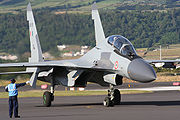
Strategic Forces Command
The Indian Strategic Forces Command , sometimes called The Strategic Nuclear Command forms part of India's Nuclear Command Authority . It is responsible for the management and administration of the country's tactical and strategic nuclear weapons stockpile...
(SFC) and these aircraft will be optimised and hardwired for nuclear weapons delivery. The SFC had previously submitted a proposal to the Indian Defence Ministry for setting up two dedicated squadrons of fighters consisting of 40 aircraft capable of delivering nuclear weapons.
HAL also expects that indigenisation of the Su-30MKI program will be completed by 2010. V. Balakrishnan, general manager of the Aircraft Manufacturing Division stated that “HAL will achieve 100 per cent indigenisation of the Sukhoi aircraft – from the production of raw materials to the final plane assembly,”. As of January 2011, 142 Su-30MKIs had been delivered to the Indian Air Force.
Upgrades
In 2004 India inked a deal with Russia to domestically produce the Novator K-100 missile for its Su-30MKI fighters. The Novator K-100 missile is designed to shoot down AWACS and other C4ISTARC4ISTAR
In military usage, a number of abbreviations in the format C followed by additional letters are used, based on expanded versions of the abbreviation C2 - command and control.C2I stands for command, control, and intelligence....
aircraft whilst keeping the launch platform out of range of any fighters that might be protecting the target.
Although not initially designed to carry nuclear or strategic weapons, the IAF will receive 40 upgraded Su-30MKIs capable of carrying the BrahMos
BrahMos
BrahMos is a stealth supersonic cruise missile that can be launched from submarines, ships, aircraft or land. It is a joint venture between Republic of India's Defence Research and Development Organisation and Russian Federation's NPO Mashinostroeyenia who have together formed BrahMos Aerospace...
cruise missile
Cruise missile
A cruise missile is a guided missile that carries an explosive payload and is propelled, usually by a jet engine, towards a land-based or sea-based target. Cruise missiles are designed to deliver a large warhead over long distances with high accuracy...
possibly by 2012. In addition, there are also plans to integrate the nuclear-capable Nirbhay missile with the aircraft as well. In May 2010, India Today
India Today
India Today is an Indian weekly news magazine published by Living Media India Limited, in publication since 1975 based in Mumbai. India Today is also the name of its sister-publication in Hindi...
reported that Russia had won a large contract to upgrade 40 Su-30MKI fighters with new radar
Radar
Radar is an object-detection system which uses radio waves to determine the range, altitude, direction, or speed of objects. It can be used to detect aircraft, ships, spacecraft, guided missiles, motor vehicles, weather formations, and terrain. The radar dish or antenna transmits pulses of radio...
s, onboard computers, electronic warfare systems
Electronic warfare
Electronic warfare refers to any action involving the use of the electromagnetic spectrum or directed energy to control the spectrum, attack an enemy, or impede enemy assaults via the spectrum. The purpose of electronic warfare is to deny the opponent the advantage of, and ensure friendly...
and the ability to carry the BrahMos missile. The first two prototypes with the 'Super-30' upgrade will be delivered to the Indian Air Force in 2012, after which the same upgrades will be performed on the last batch consisting of 40 production aircraft. The exact value of the contract is undisclosed.
India is planning to upgrade its Su-30MKI fighters with Russian Phazotron Zhuk-AE Active Electronically Scanned Array
Active Electronically Scanned Array
An Active Electronically Scanned Array , also known as active phased array radar is a type of phased array radar whose transmitter and receiver functions are composed of numerous small solid-state transmit/receive modules . AESAs aim their "beam" by broadcasting radio energy that interfere...
AESA radars. The X-band radar can track 30 aerial targets in the track-while-scan mode and engage six targets simultaneously in attack mode. AESA technology offers improved performance and reliability compared with traditional mechanically scanned array radars. Indian Defense Minister A.K Antony proposed several upgrades for the Su-30MKI to the Indian Parliament, which included fitting the fighters with Russian Phazotron Zhuk-AE AESA radars starting in 2012.
At the 2011 MAKS airshow, Irkut chairman Alexy Fedorov offered a package of upgrades to the Indian fleet to make them 'Super Sukhois'.
Airframe
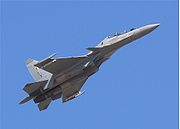
Vertical stabilizer
The vertical stabilizers, vertical stabilisers, or fins, of aircraft, missiles or bombs are typically found on the aft end of the fuselage or body, and are intended to reduce aerodynamic side slip. It is analogical to a skeg on boats and ships.On aircraft, vertical stabilizers generally point upwards...
aircraft. The airframe is constructed of titanium
Titanium
Titanium is a chemical element with the symbol Ti and atomic number 22. It has a low density and is a strong, lustrous, corrosion-resistant transition metal with a silver color....
and high-strength aluminium alloys. The engine nacelle
Nacelle
The nacelle is a cover housing that holds engines, fuel, or equipment on an aircraft. In some cases—for instance in the typical "Farman" type "pusher" aircraft, or the World War II-era P-38 Lightning—an aircraft's cockpit may also be housed in a nacelle, which essentially fills the...
s are fitted with trouser fairings to provide a continuous streamlined profile between the nacelles and the tail beams. The fins and horizontal tail consoles
Empennage
The empennage , also known as the tail or tail assembly, of most aircraft gives stability to the aircraft, in a similar way to the feathers on an arrow...
are attached to tail beams. The central beam section between the engine nacelles consists of the equipment compartment, fuel tank and the brake parachute
Drogue parachute
A drogue parachute is a parachute designed to be deployed from a rapidly moving object in order to slow the object, or to provide control and stability, or as a pilot parachute to deploy a larger parachute...
container. The fuselage
Fuselage
The fuselage is an aircraft's main body section that holds crew and passengers or cargo. In single-engine aircraft it will usually contain an engine, although in some amphibious aircraft the single engine is mounted on a pylon attached to the fuselage which in turn is used as a floating hull...
head is of semi-monocoque
Monocoque
Monocoque is a construction technique that supports structural load by using an object's external skin, as opposed to using an internal frame or truss that is then covered with a non-load-bearing skin or coachwork...
construction and includes the cockpit
Cockpit
A cockpit or flight deck is the area, usually near the front of an aircraft, from which a pilot controls the aircraft. Most modern cockpits are enclosed, except on some small aircraft, and cockpits on large airliners are also physically separated from the cabin...
, radar
Radar
Radar is an object-detection system which uses radio waves to determine the range, altitude, direction, or speed of objects. It can be used to detect aircraft, ships, spacecraft, guided missiles, motor vehicles, weather formations, and terrain. The radar dish or antenna transmits pulses of radio...
compartments and the avionics
Avionics
Avionics are electronic systems used on aircraft, artificial satellites and spacecraft.Avionic systems include communications, navigation, the display and management of multiple systems and the hundreds of systems that are fitted to aircraft to meet individual roles...
bay.
Flight control

Fly by Wire
Fly by Wire: The Geese, the Glide, the Miracle on the Hudson is a book written in 2009 by William Langewiesche about US Airways Flight 1549 with emphasis on the role played by the advanced fly-by-wire flight control system of the aircraft....
(FBW) with quadruple redundancy. Depending on the flight conditions, signals from the control stick
Joystick
A joystick is an input device consisting of a stick that pivots on a base and reports its angle or direction to the device it is controlling. Joysticks, also known as 'control columns', are the principal control in the cockpit of many civilian and military aircraft, either as a center stick or...
position transmitter or the FCS will be coupled to the remote control amplifiers. These signals are combined with feedback signals fed by acceleration sensors and rate gyros
Gyroscope
A gyroscope is a device for measuring or maintaining orientation, based on the principles of angular momentum. In essence, a mechanical gyroscope is a spinning wheel or disk whose axle is free to take any orientation...
. The resultant control signals are coupled to the high-speed electro-hydraulic actuators of the elevators
Elevator (aircraft)
Elevators are flight control surfaces, usually at the rear of an aircraft, which control the aircraft's orientation by changing the pitch of the aircraft, and so also the angle of attack of the wing. In simplified terms, they make the aircraft nose-up or nose-down...
, rudder
Rudder
A rudder is a device used to steer a ship, boat, submarine, hovercraft, aircraft or other conveyance that moves through a medium . On an aircraft the rudder is used primarily to counter adverse yaw and p-factor and is not the primary control used to turn the airplane...
s and the canard. The output signals are compared and, if the difference is significant, the faulty channel is disconnected. FBW is based on a stall
Stall (flight)
In fluid dynamics, a stall is a reduction in the lift coefficient generated by a foil as angle of attack increases. This occurs when the critical angle of attack of the foil is exceeded...
warning and barrier mechanism which prevents development of aircraft stalls through a dramatic increase in the control stick pressure. This allows a pilot
Aviator
An aviator is a person who flies an aircraft. The first recorded use of the term was in 1887, as a variation of 'aviation', from the Latin avis , coined in 1863 by G. de la Landelle in Aviation Ou Navigation Aérienne...
to effectively control the aircraft without running the risk of reaching the limit values of angle of attack
Angle of attack
Angle of attack is a term used in fluid dynamics to describe the angle between a reference line on a lifting body and the vector representing the relative motion between the lifting body and the fluid through which it is moving...
and acceleration. Although the maximum angle of attack is limited by the canards the FBW acts as an additional safety mechanism.
General features
The displays include a highly customized version of the Israeli Elbit Su 967 head-up displayHead-Up Display
A head-up display or heads-up display is any transparent display that presents data without requiring users to look away from their usual viewpoints...
consisting of bi-cubic phase conjugated holographic displays and seven liquid crystal multifunction displays, six 127 mm x 127 mm and one 152 mm x 152 mm. The HUD was widely misreported to be the VEH 3000 from Thales
Thales Group
The Thales Group is a French electronics company delivering information systems and services for the aerospace, defense, transportation and security markets...
. Variants of the same HUD have also been chosen for the IAF's MiG-27 and SEPECAT Jaguar
SEPECAT Jaguar
The SEPECAT Jaguar is an Anglo-French jet ground attack aircraft, originally used by the British Royal Air Force and the French Armée de l'Air in the close air support and nuclear strike role, and still in service with several export customers, notably the Indian Air Force and the Royal Air Force...
upgrades, on grounds of standardization. Flight information is displayed on four LCD displays which include one for piloting and navigation, a tactical situation indicator, and two for display systems information including operating modes and overall operation status. The rear cockpit is fitted with a larger monochromatic screen display for the air-to-surface missile guidance. The Su-30MKI on-board health and usage monitoring system (HUMS) monitors almost every aircraft system and sub-system including the avionics sub-systems. It can also act as an engineering data recorder
Beginning in 2010, HUDs and Multi-Function Displays (MFD) will be provided by the Delhi-based Samtel Display Systems. These are indigenously designed and built and are not part of a joint foreign venture.
Navigation
The aircraft is fitted with a satellite navigation system (A-737 GPS compatible), which permits it to make flights in all weather, day and night. The navigation complex includes the high accuracy SAGEMSAGEM
SAGEM was a major French company involved in defence electronics, consumer electronics and communication systems.In 2005, Sagem merged with SNECMA to form SAFRAN...
Sigma-95 integrated global positioning system
Global Positioning System
The Global Positioning System is a space-based global navigation satellite system that provides location and time information in all weather, anywhere on or near the Earth, where there is an unobstructed line of sight to four or more GPS satellites...
and ring laser gyroscope
Ring laser gyroscope
A ring laser gyroscope consists of a ring laser having two counter-propagating modes over the same path in order to detect rotation. It operates on the principle of the Sagnac effect which shifts the nulls of the internal standing wave pattern in response to angular rotation...
inertial navigation system.
Pilot ejection
The crew are provided with zero-zero KD-36DM ejection seats. The rear seat is raised for better visibility. The cockpit is provided with containers to store food and water reserves, a waste disposal system and extra oxygen bottlesEmergency oxygen system
Aircraft emergency oxygen systems are emergency equipment fitted to commercial aircraft, intended for use when the cabin pressurisation system has failed and the level of oxygen in the cabin atmosphere drops below a safe level...
. The KD-36DM ejection seat is inclined at 30º, to help the pilot resist aircraft accelerations in air combat.
Aerodynamics
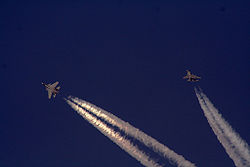
Pugachev's Cobra
In aerobatics, Pugachev's Cobra is a dramatic and demanding manoeuvre in which a plane flying at a moderate speed suddenly raises the nose momentarily to the vertical position and slightly beyond, before dropping it back to normal flight. It uses a potent engine thrust to maintain approximately...
. The integral aerodynamic configuration combined with thrust vectoring results in extremely capable maneuverability, taking off and landing characteristics. This high agility allows rapid deployment of weapons in any direction as desired by the crew. The canard notably assists in controlling the aircraft at large angles-of-attack and bringing it to a level flight condition.
Radar
The forward-facing NIIP N011M BarsBars radar
The Bars are a family of Russian all-weather multimode airborne radars developed by the Tikhomirov Scientific Research Institute of Instrument Design for multi-role combat aircraft such as the Su-27 and the MiG-29.-Description:...
(Panther) is a powerful integrated passive electronically scanned array
Passive electronically scanned array
A passive electronically scanned array , contrary to its active counterpart AESA, is a phased array which has a central radiofrequency source , sending energy into phase shift modules, which then send energy into the various emitting elements in the front of the antenna...
radar. The N011M is a digital multi-mode dual frequency band radar. The N011M can function in air-to-air and air-to-land/sea mode simultaneously while being tied into a high-precision laser-inertial or GPS navigation system. It is equipped with a modern digital weapons control system as well as anti-jamming features. N011M has a 350 km search range and a maximum 200 km tracking range, and 60 km in the rear hemisphere. The radar can track 15 air targets and engage 4 simultaneously. These targets can even include cruise missiles and motionless helicopters. The Su-30MKI can function as a mini-AWACS as a director or command post for other aircraft. The target co-ordinates can be transferred automatically to at least four other aircraft. The radar can detect ground targets such as tanks at 40–50 km. The Bars radar will be replaced by Zhuk-AESA in the last batch of 40 aircraft.
Avionics
Laser-optical locator system
OLS-30 laser-optical locator system to include a day and night FLIR capability and is used in conjunction with the helmet mounted sighting system. The OLS-30 is a combined IRST/LR device using a cooled, broader waveband, sensor. Detection range is up to 90 km, whilst the laser ranger is effective to 3.5 km. Targets are displayed on the same LCD display as the radar.LITENING targeting pod
Israeli LITENING targeting podLITENING targeting pod
The AN/AAQ-28 LITENING targeting pod is a precision targeting pod system currently operational with a wide variety of combat aircraft. LITENING significantly increases the combat effectiveness of the aircraft during day, night and under-the-weather conditions in the attack of ground and air...
is used to target the laser guided munitions. Litening incorporates in a single pod all the targeting features required by a modern strike fighter. The original Litening pod includes a long range FLIR, a TV camera, a flash-lamp powered laser designator, laser spot tracker for tracking target designated by other aircraft or from the ground, and an electro-optical point and inertial tracker, which enabled continuous engagement of the target even when the target is partly obscured by clouds or countermeasures. The pod integrates the necessary laser rangefinder and designator, required for the delivery of Laser Guided Bombs, cluster and general purpose bomb.
Electronic countermeasures
Sukhoi Su-30MKI has electronic counter-measure systems. The RWR system is of Indian design, developed by India's DRDO, called Tarang, (Wave in SanskritSanskrit
Sanskrit , is a historical Indo-Aryan language and the primary liturgical language of Hinduism, Jainism and Buddhism.Buddhism: besides Pali, see Buddhist Hybrid Sanskrit Today, it is listed as one of the 22 scheduled languages of India and is an official language of the state of Uttarakhand...
). It has direction finding capability and is known to have a programmable threat library. The RWR is derived from work done on an earlier system for India's MiG-23BNs known as the Tranquil, which is now superseded by the more advanced Tarang series. Elta EL/M-8222 a self-protection jammer developed by Israel Aircraft Industries is the MKI's standard EW pod, which the Israeli Air Force uses on its F-15s. The ELTA El/M-8222 Self Protection Pod is a power-managed jammer, air-cooled system with an ESM receiver integrated into the pod. The pod contains an antenna on the forward and aft ends, which receive the hostile RF signal and after processing deliver the appropriate response.
Propulsion
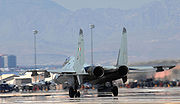
KGF
KGF may refer to:*Keratinocyte Growth Factor*King George's Fields A UK set of 471 memorial playing fields and recreation grounds*Kolar Gold Fields*The IATA code for Sary-Arka Airport, Karaganda, Kazakhstan...
(27,550 lbf) of full afterburning thrust. These by-pass, thrust-vectoring engines push the aircraft up to mach two in horizontal flight (about 2450 km/h at ground-level) and give a rate of climb of 230 m/s. The mean time between overhaul for the AL-31FP is given at 1,000 hours with a full-life span of 3,000 hours. The titanium nozzle has a mean time between overhaul of 500 hours. Al-31FP builds on the Al-37FU with the capability to vector in two planes. The Thrust Vectoring
Thrust vectoring
Thrust vectoring, also thrust vector control or TVC, is the ability of an aircraft, rocket or other vehicle to manipulate the direction of the thrust from its engine or motor in order to control the attitude or angular velocity of the vehicle....
nozzles of the MKI are mounted 32 degrees outward to longitudinal engine axis (i.e. in the horizontal plane) and can be deflected ±15 degrees in the vertical plane. This produces a cork-screw effect, thus enhancing the turn capability of the aircraft. There is no strain-gauge engine control stick to change the engine thrust in the cockpit, rather just a conventional engine throttle control lever. The pilot controls the aircraft with help of a standard control stick. On the pilot's right there is a switch which is turned on for performing difficult maneuvers. After the switch-over, the computer determines the level of use of aerodynamic surfaces and swiveling nozzles and their required deflection angles.
Fuel system
The Su-30MKI has a range of 3,000 km with internal fuel which ensures a 3.75 hour combat mission. Also, it has an in-flight refueling (IFR) probe that retracts beside the cockpit during normal operation. The air refueling system increases the flight duration up to 10 hours with a range of 8,000 km at a cruise height of 11 to 13 km. Su-30 MKIs can also use the Cobham 754 buddy refueling pods.Joint Exercises
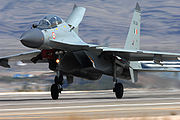
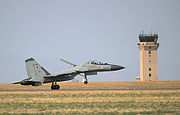
Military simulation
Military simulations, also known informally as war games, are simulations in which theories of warfare can be tested and refined without the need for actual hostilities. Many professional contemporary analysts object to the term wargames as this is generally taken to be referring to the civilian...
. India exercised its Su-30MKIs against the Royal Air Force
Royal Air Force
The Royal Air Force is the aerial warfare service branch of the British Armed Forces. Formed on 1 April 1918, it is the oldest independent air force in the world...
's Tornado ADVs
Panavia Tornado ADV
The Panavia Tornado Air Defence Variant is a long-range, twin-engine interceptor version of the swing-wing Panavia Tornado. The aircraft's first flight was on 27 October 1979, and it entered service in 1986. It was retired on 22 March 2011 by the Royal Air Forceand is now only in service with the...
in October 2006. This was the first large-scale bilateral aerial exercise with any foreign air force during which the IAF used its Su-30MKIs extensively. This exercise was also the first in 43 years with the RAF. During the exercise, RAF's Air Chief Marshall, Glenn Torpy, was given permission by the IAF to fly the MKI. RAF's Air-Vice Marshall, Christopher Harper, praised the MKI's dogfight ability, calling it "absolutely masterful and unbeatable".
In July 2007, the Indian Air Force fielded the MKI during the Indra-Dhanush exercise with Royal Air Force's Eurofighter Typhoon
Eurofighter Typhoon
The Eurofighter Typhoon is a twin-engine, canard-delta wing, multirole combat aircraft, designed and built by a consortium of three companies: EADS, Alenia Aeronautica and BAE Systems; working through a holding company, Eurofighter GmbH, which was formed in 1986...
. This was the first time that the two jets had taken part in such a exercise. The IAF did not allow their pilots to use the radar of the MKIs during the exercise so as to protect the highly classified N011M Bars. Also in the exercise were RAF Tornado F3s and a Hawk. RAF Tornado pilots were candid in their admission of the Su-30MKI's superior manoeuvring in the air, but the IAF pilots were also impressed by the Typhoon's agility. The summary of the Indra-Dhanush is often mis-quoted by leaving the word "Tornado" out of the statement, to make it appear that the Typhoon was less manoeuvrable than the Su-30MKI. The RAF however, were adamant that the Typhoon and Sukhoi did not actually go head to head in mock combat on that particular exercise.
India sent Su-30MKs, an earlier variant of the Su-30MKI, to took part in war games with the United States Air Force
United States Air Force
The United States Air Force is the aerial warfare service branch of the United States Armed Forces and one of the American uniformed services. Initially part of the United States Army, the USAF was formed as a separate branch of the military on September 18, 1947 under the National Security Act of...
(USAF) during Cope-India 04
Cope India
Cope India are a series of international Air Force exercises between the United States Air Force and the Indian Air Force conducted on and over Indian soil. The first such exercise, which required many months of preparation, was conducted at the air force station in Gwalior from February 16 through...
in 2004. The results have been widely publicized, with the Indians winning "90% of the mock combat missions" against the USAF's F-15C.
In July 2008, the IAF sent 6 Su-30MKIs and 2 Il-78MKI
Ilyushin Il-78
The Ilyushin Il-78 is a four-engined aerial refueling tanker based on the Il-76.-Design and development:...
aerial-refueling tankers, to participate in the Red Flag exercise. The IAF again did not allow their pilots to use the radar of the MKIs during the exercise so as to protect the highly classified N011M Bars. In October 2008, a video surfaced on the internet which featured a USAF colonel, Corkey Fornoff, criticizing Su-30MKI's high friendly kill rate, serviceability issues, and relatively poor performance against the F-15C during the Red Flag exercise. Several of his claims were later rebutted by the Indian side and the USAF also distanced itself from his remarks.
In June 2010, India and France began the fourth round of their joint air exercises, "Garuda", at the Istres Air Base in France. During Garuda, the IAF and the French Air Force
French Air Force
The French Air Force , literally Army of the Air) is the air force of the French Armed Forces. It was formed in 1909 as the Service Aéronautique, a service arm of the French Army, then was made an independent military arm in 1933...
were engaged in various missions ranging from close combat engagement of large forces, slow mover protection, protecting and engaging high value aerial assets. This exercise marked the first time SU-30 MKI took part in an military exercise in France.
Operators
- Indian Air ForceIndian Air ForceThe Indian Air Force is the air arm of the Indian armed forces. Its primary responsibility is to secure Indian airspace and to conduct aerial warfare during a conflict...
has 149 Su-30MKIs in service as of July 2011. Presently, India has positioned its Sukhois only at Bareilly, Pune and Jodhpur, Tezpur Air Force Station, AssamAssamAssam , also, rarely, Assam Valley and formerly the Assam Province , is a northeastern state of India and is one of the most culturally and geographically distinct regions of the country...
, Chabua Air Force Station, AssamAssamAssam , also, rarely, Assam Valley and formerly the Assam Province , is a northeastern state of India and is one of the most culturally and geographically distinct regions of the country...
.
Notable accidents
A Su-30MKI aircraft crashed on 30 April 2009 in the Pokhran region of Rajasthan after it took off from Pune during its routine sortie, killing one of its two pilots. Defence minister A. K. AntonyA. K. Antony
Arackaparambil Kurien Antony is an Indian National Congress politician, a former Chief Minister of Kerala, and the current Defence Minister of India....
, stated that the likely cause of the 30 April crash was "failure of the fly-by-wire
Fly-by-wire
Fly-by-wire is a system that replaces the conventional manual flight controls of an aircraft with an electronic interface. The movements of flight controls are converted to electronic signals transmitted by wires , and flight control computers determine how to move the actuators at each control...
system". The Sukhoi fleet had then been grounded for around three weeks. However it was found that this crash at Rajmathai village, around 170 km from Jaisalmer, in April was because of the position of the various critical switches of the aircraft. The switches were behind the pilots and they would have to turn them on and off without looking back. At one point, a wrong switch was turned on, leading to the crash on 30 April. Wing Commander PS Nara was killed in the mishap, while Wing Commander SV Munje was injured. After investigators identified the problem, a couple of difficult switches were sealed off.
Another Su-30MKI aircraft crashed on 30 November 2009 in Jathegaon, about 40 km from Jaisalmer. The pilots ejected after they saw fire alarm buttons glowing red. Both the pilots are unharmed. This is second such crash of this fighter. The Sukhoi mishaps have come as a setback to the 12 year safety record IAF had achieved with the aircraft which was inducted into the force in 1997. As a result the entire fleet of Su-30MKIs was grounded while the cause of the problem was investigated. It was attributed to accidental ingestion of a foreign material in the engine intake.
Specifications (Sukhoi Su-30MKI)
See also
External links
- Su-30MKI Photo in Special Indian Tri-Colour Livery
- Su-30 Photo Pool on Flickr
- Extensive Technical Information about Su-30MKI
- Core Avionics for Su-30 MKI
- Boein Interview about MKI with Alexey I. Fedorov (23 April 2002), the president of the Irkutsk Aviation Industrial Association, responsible for delivery of Su-30MKI to India
- A news report on the Su-30MKI in an air exercise with the Royal Air Force
- Video at YouTube
- President of India Mrs. Pratibha Patil Becomes First Woman President to Fly in Sukhoi 30MKI

